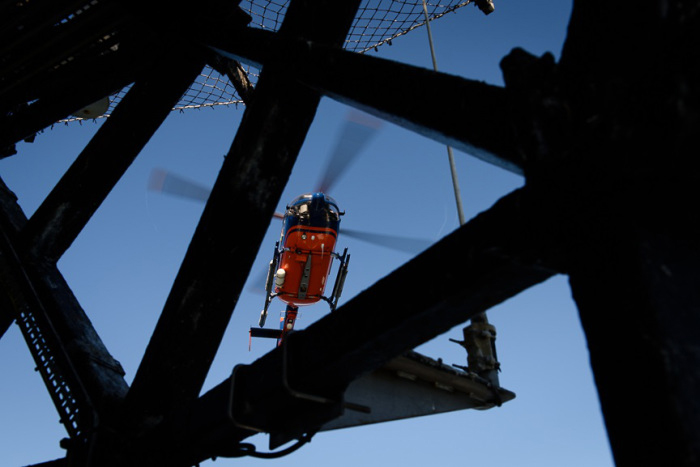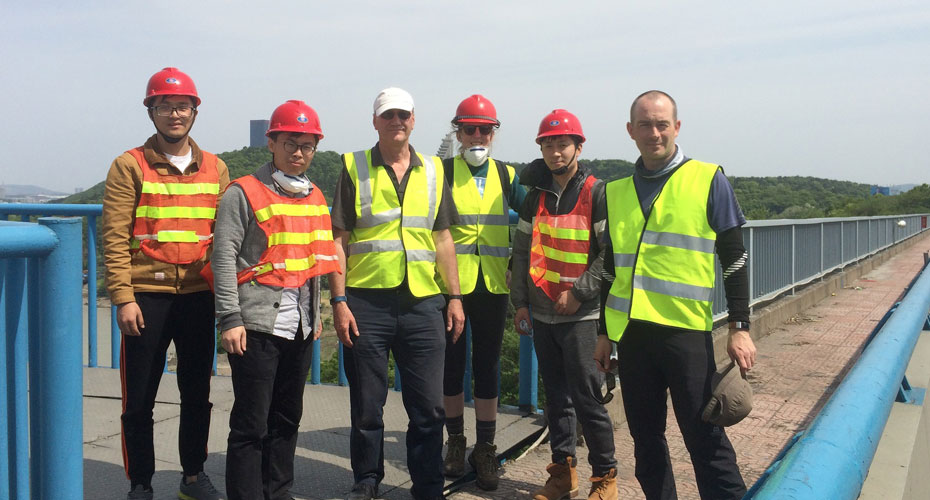Brownjohn JMW, Au SK, Zhu Y, Sun Z, Li B, Bassitt J, Hudson E, Sun H. Bayesian operational modal analysis of Jiangyin Yangtze River Bridge. Mechanical Systems and Signal Processing 2018 110 210-230 DOI: 10.1016/j.ymssp.2018.03.027
Testing and maintaining Jiangyin Suspension Bridge
Case Study: Jiangyin
VES used pioneering technologies to carry out a modal test of the 1,385m span Jiangyin Suspension Bridge, in a collaboration with JSTI, China.
As well as assessing the bridge’s structural condition and informing plans for its maintenance, the project tested the capabilities of two new technologies for measuring vibrations.
Professor James Brownjohn and researchers from the Universities of Exeter, Liverpool and the UK Tongji University, China travelled to Jiangyin in Jiangsu province, China as part of the EPSRC-funded BAYOMALAW project.
Synchronised wireless vibration loggers
Modal analysis (measuring how structures respond to vibrational excitation) can offer insight into the design and maintenance of resilient civil structures such as bridges and skyscrapers. However, the enormity of these structures means traditional, wired data loggers are simply not fit for this purpose.
To solve this problem, VES have developed a bespoke synchronised wireless data logging system that can be widely distributed across huge structures, whilst maintaining sub-microsecond synchronisation without logistically challenging cables or GPS antennae. The loggers were was created by James Bassitt (hardware), Vincent Ao and Emma Hudson (software).
Four loggers were taken to China, along with 12 force balance accelerometers and short signal cables. These loggers were synchronised to a fraction of a microsecond before a measurement, then distributed over the bridge deck and towers in a sequence of measurements to record ambient vibration signals.
Over three days, 14 separate measurements were taken and, for each measurement, the master logger was left recording vertical and lateral vibrations continuously at two hanger locations on the east walkway. Meanwhile, other (slave) loggers were ‘roved’ to record for at least an hour synchronously at other locations on the east and west sides and inside the south tower.

Professor Brownjohn's research collaboration with JSTI helped us a lot. The vibration test results are useful for evaluating the health condition of Jiangyin Bridge. Based on the results from the research, a wiser maintenance plan has been made.
Zhen Sun, JSTI
Modal analysis
The second major technology evaluated was the operational modal analysis planning and evaluation procedure developed by Professor Siu-Kui Au’s group as part of the BAYOMALAW collaboration with the University of Liverpool.
As part of the procedure, a ‘huddle test’ is used to check the self-noise and environmental noise of the measurement system. To do this, all sensors are huddled into one location and sense either vertical or lateral vibrations simultaneously.
The exercise required a large investment of resource into building, programming, delivering and operating the system on site – but preliminary analysis of the data shows the exercise was successful. The test was supported by Tongji University and global engineering consultancy firm JSTI.
In addition, Professor Brownjohn was invited by JSTI to provide lectures on bridge inspection technologies, vibration measurement, data processing and structural modelling, aiming to improve technologies in health monitoring of large span bridges and to develop research collaboration.
Zhen Sun, JSTI, said: “Professor Brownjohn's research collaboration with JSTI helped us a lot. The vibration test results are useful for evaluating the health condition of Jiangyin Bridge. Based on the results from the research, a wiser maintenance plan has been made.”

More information
-
Consultancy and industry: Find out more about how we can help you and how to get in touch
-
Research: Meet our academic staff and view their research profiles


